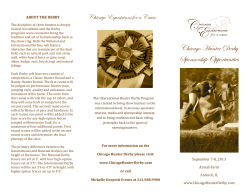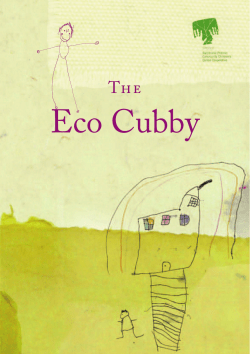
state of state of play play the
the state of play in Chicago’s communities The mission of Chicago Children’s Museum is to create a community where play and learning connect. CCM is the only cultural institution in the city dedicated to young children and the important adults in their lives. Fifteen permanent exhibits and programming spaces provide innovative learning experiences for children and their caregivers. CCM invests significant resources in neighborhoods across Chicago, particularly those with limited access to the museum’s rich learning opportunities. introduction Play is essential to childhood and is a core tenet of Chicago Children’s Museum’s (CCM) mission. A significant body of research demonstrates that play enhances every domain of a child’s development. It is the natural, age-appropriate way for children to explore, create, discover and learn. Because play is central to CCM’s practice, and because the museum works to respond directly to the needs defined by its community, CCM developed the Chicago Communities at Play Initiative. Aimed at better understanding parent and educator beliefs about the role of play and the issues that hinder or support it, the Initiative gathered adults from across Chicago to identify those issues, share knowledge about the value of play, and develop strategies for supporting play in their homes, schools, and communities. Play is the natural, age-appropriate way for children to explore, create, discover and learn. about the initiative Chicago Children’s Museum spent eight months researching the state of play in Chicago, and facilitating communitybased workshops on play and its connection to learning. CCM worked with parents, classroom teachers, childcare providers, youth and social service educators, family advocates, and community organizers from diverse neighborhoods, backgrounds, economic levels, races, and ethnicities. Despite differences, participants were united in their attitudes about the importance of play. An online survey was designed to gather baseline information about play and local issues hindering children’s opportunities for play. While nearly all respondents recognized value in play, more than half also noted barriers. Among the most commonly cited by educators was the absence of recess for their students, while parents reported a lack of time and available space, as well as concerns about violence and safety. In addition, the museum conducted 20 community-based workshops, consisting of week-long residencies in four Chicago neighborhoods: Englewood, Humboldt Park, Pilsen, and Rogers Park. Five workshops were offered in each neighborhood—two for educators, two for parents, and one for Chicago Park District staff. Each workshop included group dialogue and hands-on activities. From the Chicago Communities at Play Initiative emerged common understandings and beliefs about the importance of play, as well as a number of real and perceived barriers to play. This report highlights these findings and, in response, proposes action steps for making play more widely accessible. While nearly all respondents recognized value in play, more than half also noted barriers. “Play is many different things. It is not always physical, loud, or boisterous. But it is the process of figuring out how to be in the world.” —Kenna, a parent and museum educator 2 importance of play value of play Participants universally agreed that play is valuable to children’s healthy development. “Kids learn through play,” said one Rogers Park parent. “Play provides a pleasurable way for a person to revisit learned knowledge, practice skills being acquired, extend learning, build relationships with others and their environments, and to have the sense of self-direction and capability,” stated a childcare provider from Chicago’s West Side. Many participants recognized that play is the means by which children make sense of their world—that they build understanding through active participation. “All children can learn through play,” commented an early childhood educator. “It is universal.” the opportunity to build socialization skills,” noted another educator. “It helps brain development, fosters imagination, and helps language development,” noted a Woodlawn classroom teacher. “Love, laughter, happiness, and security can all be found, and nurtured, through play,” commented a Head Start Program educator. common understandings & beliefs about play In addition to the shared belief that children learn through play and that play is the means by which children make sense of their world, the survey revealed other common understandings: Children have a natural and universal inclination to interact with the world. impact of play Children experience learning with their whole selves. A significant body of research recognizes the impact of play on all areas of a child’s development, including physical1, social-emotional2, and cognitive function3. Participants in the Initiative corroborated these findings with their own observations from raising, educating, and caring for children. “[Play] builds [children’s] large and small motor skills,” said one South Shore childcare provider. “Play gives children Play comes in many forms: structured, unstructured, independent, collaborative, physical, and expressive. Play looks different for children of varying ages, developmental levels, personalities, and life contexts. Above: Costumes and props can help children pretend, but they don’t need to be elaborate. Here, workshop participants engage in pretend play with open-ended materials, like balls and tubes. 1 Pellegrini & Smith, 1998; Oliver & Klugman, 2002 2 Coplan & Rubin, 1998 3 Bergen, 2002; Singer, 2002; Oliver & Klugman, 2002; Pellegrini & Smith, 1998 “When children play, they learn the skills they need to succeed in life.” —Daycare provider, survey participant 3 barriers to play Despite the widely-recognized value of play, many of the parents, educators, and community stakeholders who took part in the Initiative expressed a deep concern over the decreasing presence of play in children’s lives and diminished opportunities for meaningful, child-centered play. Participants acknowledged common and widespread barriers to children’s play: Society does not value play. Educational laws and policies, societal discourses, and even casual conversations with family and friends often frame children’s participation in play as “just” play—something expendable that fills children’s time. Many surveyed—parents and educators alike—feel pressured to keep children busy with activities “more meaningful” than play. Play, especially outdoor play, is unsafe in many Chicago neighborhoods. One community educator, who teaches children ages six to 12, said, “I work in a community where there is a lot of violence. So even if kids wanted to be themselves [and play freely outdoors], their parents are concerned about—you know—that drive-by. So they make them stay inside… [So, ‘free play,’] it’s not possible.” For many adults, violence, crime, drugs, and gangs affect everyday choices and efforts to keep children safe. Despite very real dangers, adult perceptions of danger can also greatly limit children’s access to play. Adults often place unnecessarily strict boundaries on children’s play as a result of their own safety concerns. Adults limit the presence and quality of play. Many participants feel limited in their efforts to support children’s play because of the beliefs and actions of other adults. Participants painted a scenario in which parents express frustration that school educators eliminate play in favor of “teaching to the tests,” while classroom teachers believe parents view play as oppositional to the development of “competitive” children. Educators grapple with administrators who forbid play in the classroom, while administrators assert that educators don’t utilize more playful curricula. Among these disparate groups is the mutual acknowledgement that adults often view other adults as impediments to children’s meaningful play. Adults are not aware of the connections between play and children’s healthy development. Adults often associate learning with structured sessions, during which students are expected to master specific content. Play is often unrecognized as an equally valuable model for learning. “[Parents] want structure all the time,” said a Chicago Park District educator. “They think their kids aren’t learning [through play] when [in fact] they are.” There are not enough resources, strategies, or models to help parents and educators meaningfully support play. Many surveyed parents and educators expressed a need for more knowledge and resources for supporting play. “[I want to learn] other ways I can help my grandchildren learn and play together,” noted a South Side grandparent. Another educator acknowledged a “fear of losing a tie to [educational] standards” by incorporating play in the classroom, and expressed a desire for help in making this link. Children don’t know how to play. Many participants expressed concern that today’s children have lost the ability to use their imaginations, cannot self-entertain, and do not know what to do when given the option to play freely. As one Chicago Park District employee said, “Kids [have an] attachment to iPods, mp3 players, cell phones, etc. They don’t know what to do when using their imagination. They turn to their stuff.” Parents and educators feel pressured to keep children busy with activities “more meaningful” than play. “We want kids to have a time every day—especially when they’re really young— when they can have free play, totally open.” —B., a parent 4 action steps for change Perhaps the most consistent and overarching sentiment to emerge from the Initiative was a general sense of isolation among adults in their desire to support play. While all strongly valued play and spoke of a personal commitment to increase opportunities for play, they did not feel connected to a network of others who shared their beliefs. Chicago Children’s Museum’s mission—to create a community where play and learning connect—focuses on building a network of caregivers and educators who support play, both within the museum and beyond its walls. The Initiative confirmed that the need for this sort of community building is greater than ever. Building on more than 25 years of experience, the museum will lead efforts to improve the state of play in Chicago’s communities. The following recommended action steps focus on connecting, collaborating, and educating. CCM is joined in these efforts by the growing community of play advocates developed through the Initiative. • Unite. Chicago Children’s Museum will serve as a town square for dialogue among community stakeholders. Adults must resist the urge to affix blame for the current condition of play in communities and, instead, build alliances that support it. Widespread change begins locally. Together, parents, educators, and policy makers can strategically target specific community needs and concerns, taking action to encourage positive change. Educate. CCM will provide ongoing education for adults on the topic of developmentally-appropriate practice. Play advocates must understand how children develop, identify the connections between play and learning, and share strategies that support children’s play. Empower. Through extensive community engagement, CCM will build knowledge and resources to ensure that adults in communities across Chicago have the ability to support play. Commonly shared strategies include providing children with the following: • Ample free time for free play. When children engage deeply, the positive impact on their development increases. • Physical and emotional space to play. Creating spaces in homes, schools, and communities makes children feel safe, empowered, and encouraged to play. • Engaging, open-ended materials. Everyday items allow children to tap into their own limitless imaginations. Examples include fabric, boxes, leaves, cardboard tubes, newspaper, and other household and natural objects. Above: Like these workshop participants, children unleash their creativity when they build their own structures with boxes, tape, sheets, and blankets. “[As educators, we need to] let parents know that they are always welcome…If they have an idea, give it to us or even join in with us.” —Monica, a Chicago Park District educator 5 conclusion • Control of their own play. Allowing children to direct how and with whom they play leads to more meaningful experiences. • Positive behavioral models. When children play with adults, they have an opportunity to develop skills, such as sharing, negotiating, and problem-solving. • Opportunities to show who they are. By intentionally observing and reflecting on children’s play, adults discover their abilities, temperaments, interests, and ideas about the world—enabling them to better support the child’s development. • The attention of a caring adult. Asking open-ended questions, such as, “Tell me about what you’ve created,” encourages deeper discussions about play experiences. Inspire: The museum will engage adults and children in memorable play experiences. When adults personally experience the value of play, they are motivated to support it. When children play, they become better players, increasing their capacity to make meaning of the world around them. Through the Chicago Communities at Play Initiative, parents, educators, and community stakeholders demonstrated a belief in the power and necessity of play. The Initiative laid a foundation for a network of play supporters who will continue to work in ways both large and small to promote change in their communities. Many participants, for example, noted plans to train others using content learned through the Initiative. A number of educators stated that they would continue to research ways of incorporating play into their classroom curriculum. Many parents avowed a renewed commitment to “making more time” for play in their children’s lives. These intentions and actions are promising—and speak to a hopeful future for the state of play in Chicago’s communities. Chicago Children’s Museum, through its everyday work, will continue to provide leadership and support for the ongoing and growing effort to make play a fundamental experience for all children in all communities. Chicago Children’s Museum will continue to provide leadership for the growing effort to make play a fundamental experience for all children in all communities. “My role [is] to coordinate and observe and not always lead or control.” —Carol, a visual arts educator 6 appendix An online survey and a series of community-based workshops served as the basis of this report. online survey Chicago Children’s Museum utilized an online survey to gather baseline information about play and local issues hindering children’s play opportunities. One hundred fourteen respondents accessed the survey between October 28, 2008, and April 4, 2009. Developed by CCM staff, with the guidance of play experts, the survey included multiple-choice and open-response questions. Survey participants included museum members and the wider community. Of the total respondents, 21.9% (25 participants) self-identified as parents and 79.8% (91 participants) self-identified as childcare providers or educators.4 Childcare providers include those working with children under the age of 12 in schools, Head Start and Early Head Start programs, community centers, childcare centers, or other service agencies providing support to children, families, or educators. Of those in a school setting, one-third (27) taught students without a recess period. Because the survey required Internet access and was limited to CCM contacts, data findings do not represent the full population of persons working with children in Chicago. community-based workshops Between April 14 and May 15, 2009, the museum conducted 20 workshops, hosted at Chicago Park District facilities in the Englewood, Humboldt Park, Pilsen, and Rogers Park communities. The selected neighborhoods spanned all quadrants of the city, targeting underserved, racially-diverse, low- and middle-income communities. A total of 109 adults participated in the workshops, including 65 Chicago Park District staff members, 35 educators, and nine parents—many of whom interact with children in multiple roles. Seventy-five percent of all participants (159/211) lived or worked in the following Chicago communities:5 Bridgeport Bronzeville/Near South Side Cabrini/Near North Side Chinatown Englewood/West Englewood Humboldt Park Logan Square Near West Side Pilsen Rogers Park South Lawndale Uptown Washington Park West Town 4 Because some respondents selected both “parent” and “educator/childcare provider” as their primary role, the results added up to more than 100%. 5 This figure includes 83% (91/109) of workshop participants and 67% (68/102) of survey respondents. “Play is something that is cherished with your child.” —Parent survey participant 7 references Bergen, Doris, “The Role of Pretend Play in Children’s Cognitive Development,” Early Childhood Research and Practice, 4(1), Spring 2002. Coplan, Robert J., and K.H. Rubin, “Social Play,” Play from Birth to Twelve and Beyond, Garland Press, 1998. Hawley, Theresa, “Starting Smart: How Early Experiences Affect Brain Development,” Zero to Three National Center for Infants, Toddlers, and Families, 1998. Oliver, Susan J., and Edgar Klugman, “What We Know About Play,” Child Care Information Exchange, September 2002. Pellegrini, Anthony D., and P.K. Smith, “Physical Activity Play: The Nature and Function of a Neglected Aspect of Play,” Child Development 69(3), June 1998. Singer, Jerome L., “Cognitive and Affective Implications of Imaginative Play in Childhood,” Child and Adolescent Psychiatry: A Comprehensive Textbook, Melvin Lewis, ed., 2002. other resources Brown, Stuart, Play: How It Shapes the Brain, Opens the Imagination, and Invigorates the Soul, Avery, 2009. Jarrett, Olga S., “Recess in Elementary School: What Does the Research Say?” ERIC Digest, Champaign, IL, ERIC Clearinghouse on Elementary and Early Childhood Education, 2002. Singer, Dorothy, Roberta Michnick Golinkoff, and Kathy Hirsh-Pasek, editors, Play = Learning: How play motivates and enhances children’s cognitive and social-emotional growth, New York, NY, Oxford University Press, 2009. United Nations High Commission for Human Rights, United Nations Convention on the rights of the child, November 1989, www2.ohchr.org/english/law/crc.htm. acknowledgements To our generous funder, the Marguerite Casey Foundation, whose financial support made this work possible. To our community participants: Your dedication to and advocacy for play and its ability to improve the lives of children made this study possible. Thank you for sharing your stories, your struggles, and your ideas. The work you do every day has the potential to change lives. To our partners, staff, and consultants who contributed time, attention, and resources to many aspects of this work: You spread word of this project, extending the conversation to new friends, provided space for us to gather, and offered continual and invaluable feedback throughout the process. We especially want to acknowledge the following organizations and individuals for their contributions: Joan Almon, Director of the Alliance of Childhood; the Chicago Department of Family and Support Services; the Chicago Park District; and Penny Wilson, London-based playworker. Jensen, Eric, Teaching with the Brain in Mind, Association for Supervision and Curriculum Development, 1998. Kaiser Family Foundation Generation M, Media in the lives of eight to eighteen year olds, March 2005, www.kff.org/entmedia/entmedia030905pkg.cfm. Miller, Ed and Joan Almon, Crisis in the Kindergarten: Why Children Need to Play in School, Alliance for Childhood, 2009. Raymond, Alan, and Susan S. Raymond, Children in War, New York, NY, TV Books, 2000. “When children play, they really put their all into it. They don’t hold back.” —Cherise, a workshop participant 8 Editors: Joan Bernstein, Natalie Bortoli, Kylia Kummer, Nancy Plaskett Workshop facilitators: Kenna Hart, Derek Moore, Kate Stone Documenter, research writer, and workshop photographer: Kelly Baldwin Designer: Valerie Hebda Some images are from iStockphoto. “Sometimes kids are the best teachers.” —Mike, a Chicago Park District educator Chicago Children’s Museum Navy Pier 700 East Grand Avenue, Suite 127 Chicago, Illinois 60611 312-527-1000 www.chicagochildrensmuseum.org
© Copyright 2025



















